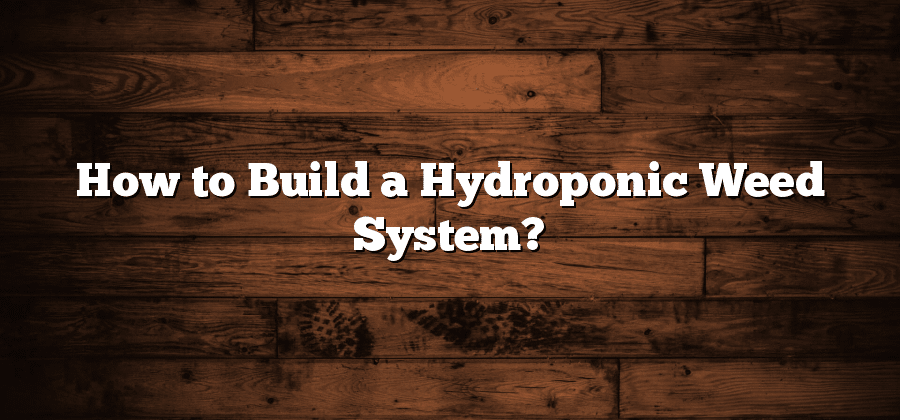Understanding the Basics of Hydroponic Cultivation
Hydroponic cultivation is a modern and innovative method of growing plants without the need for soil. Instead, plants are grown in a nutrient-rich water solution that provides all the essential elements for their growth. This cultivation technique has gained popularity in recent years due to its numerous advantages.
The main advantage of hydroponic cultivation is the increased control over the growing environment. With this method, factors such as temperature, pH levels, and nutrient concentrations can be easily regulated, resulting in optimal growing conditions for the plants. Additionally, hydroponics allows for increased crop yields and faster growth rates compared to traditional soil-based cultivation. This makes it an attractive option, especially for growers with limited space or unfavorable soil conditions.
Selecting the Right Weed Strains for Hydroponics
When it comes to selecting the right weed strains for your hydroponics setup, there are a few key factors to consider. First and foremost, it’s important to choose strains that are known for thriving in hydroponic environments. These strains have been specifically bred and cultivated to excel in soilless systems, making them the ideal choice for hydroponic growers.
Another important factor to consider is the desired effects of the weed strains. Different strains have different cannabinoid profiles, which determine the specific effects they produce. Whether you’re looking for a strain that provides a relaxing body high or one that offers a cerebral, uplifting experience, choosing strains that align with your desired effects will ensure a satisfying and enjoyable harvest. Keep in mind that strains with higher levels of THC may require more advanced hydroponics techniques to optimize their potential.
Choosing the Ideal Location for Your Hydroponic Setup
When it comes to setting up a hydroponic system, choosing the right location is crucial for ensuring the success of your cultivation. While hydroponics eliminates the need for soil, it doesn’t mean that any place will do. One of the primary considerations when selecting a location is access to natural light. For optimal growth and development, your hydroponic setup should be placed in a spot that receives ample sunlight throughout the day. Ideally, this should be a south-facing area that gets at least 6-8 hours of direct sunlight. If natural light is limited, you might need to invest in supplemental grow lights to provide the necessary light spectrum for your plants.
Another important aspect to consider when choosing a location for your hydroponic setup is temperature and ventilation. Most plants thrive when the temperature ranges between 70 and 80°F (21 to 27°C). Therefore, it’s crucial to avoid placing your system in areas that are prone to extreme temperature fluctuations. Additionally, good ventilation is necessary to prevent the build-up of humidity, which can lead to the growth of mold and fungi. Ensuring a steady flow of fresh air can be achieved through the use of fans or by placing your system in an area with natural air circulation.
By carefully selecting the ideal location for your hydroponic setup, you can provide your plants with the optimal growing conditions they need to thrive. Keep in mind the importance of natural light, temperature, and ventilation when determining the best spot for your cultivation. In the next section, we will discuss the essential tools and equipment you’ll need to build your hydroponic system.
Essential Tools and Equipment for Building a Hydroponic System
When it comes to building a hydroponic system, having the right tools and equipment is essential for success. One of the most important tools you will need is a pH meter or test kit. This will allow you to monitor the pH levels of your nutrient solution, ensuring that it remains within the optimal range for plant growth. Additionally, a TDS meter is necessary to measure the total dissolved solids in the solution, giving you a better understanding of the nutrient concentration. Other essential tools include a water pump, air pump, and air stones, which help to oxygenate the water and provide circulation to the roots of your plants.
In terms of equipment, a good quality light source is crucial for the proper growth of your hydroponic plants. LED grow lights are the most popular choice among growers due to their energy efficiency and ability to provide a full spectrum of light. Reflective material or a grow tent is also advisable to maximize the efficiency of your lighting setup. Additionally, a reservoir or nutrient tank is necessary to hold and mix your nutrient solution, while a timer will allow you to automate the lighting and watering cycles. Lastly, don’t forget about essential safety equipment like gloves and goggles to protect yourself during the construction and maintenance of your hydroponic system.
Building the Foundation: Constructing the Hydroponic Grow Bed
Constructing the hydroponic grow bed is an essential step in setting up your hydroponic system. This is where your plants will grow and thrive, so it’s crucial to build a strong and efficient foundation. The first consideration when constructing the grow bed is the material. You can use a variety of options such as plastic, wood, or even concrete. Each material has its pros and cons, so it’s important to choose the one that suits your needs, budget, and preferences the best.
Once you have selected the material, the next step is to determine the size and shape of the grow bed. Consider the space available and the number of plants you intend to grow. It’s crucial to ensure that the bed is deep enough to accommodate the root systems of your plants. Additionally, think about the accessibility of the grow bed for maintenance and harvesting purposes. Don’t forget to include drainage holes to prevent waterlogging, as this can lead to root rot and other problems. By carefully considering these factors, you can construct a hydroponic grow bed that provides a sturdy and functional foundation for your plants to flourish.






